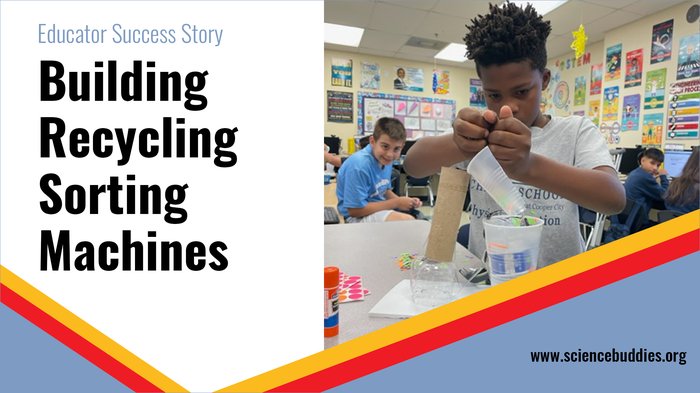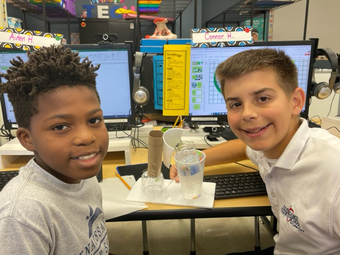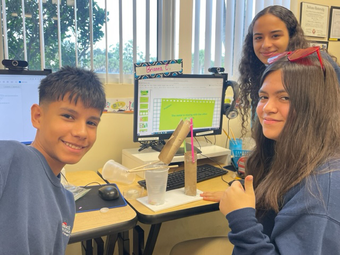Making Recycling Sorting Machines—STEM Success
This teacher had students design and build sorting machines as part of an environmental science engineering unit.

Connecting Engineering to Real-world Problems
The Recycling Challenge
Kelly Long teaches an Exploring Engineering Tech elective to middle school students at Renaissance Charter School, a K-8 charter school in Cooper City, FL. As part of a "Human Impact on the Environment" unit, Kelly had students design and build machines to model the process of sorting recycled materials at a materials recovery facility.
Proper and efficient sorting is a complicated but necessary part of the single stream recycling process. The Build a Recycling-Sorting Machine lesson helps students explore the challenge and different technologies and approaches that may be used, including magnetism. Students then use the engineering design process to think through the problem and build their own model STEM-based sorting devices to separate paper clips from shreds of paper.
We caught up with Kelly to hear how the engineering project went with her middle school students.
What led you to this lesson? Were you teaching a related topic? Or were you looking for something that fit a specific kind of problem?
"I was preparing my lesson plans for a unit on 'Human Impacts on the Environment' when I received your 'Celebrate National STEM Day!' email. In the email, there was a link to the Build a Recycling-Sorting Machine lesson. We usually discuss the issues with landfills and why most items we 'think' are recyclable are not."
It sounds like this was a good engineering tie-in. How did the STEM lesson go?
"We had many successes. The students were perplexed at times and had to really rack their brains to figure out how to only get the paper clips 'grabbed' and not the paper. Some made the exit too small, and when the paper clips were collected, there was not enough space for the paper bits to fall through. They had to really think about where to place the magnets."
This kind of troubleshooting and iteration is such an important part of the engineering process. What other skills did this experiment emphasize for your students?
"Critical thinking skills! We discuss and research the problem, and I give them the materials. It is up to them to work with their partner to brainstorm ideas, build it, test it, and iterate their builds to solve the problem. This was only our 2nd project of the year. (We also built a paper table that would hold a ream of paper.) This project really allowed them to use critical thinking skills in seeing their mistakes and figuring out a way to solve them."


What is your favorite part about teaching engineering to middle school students?
"My favorite part is watching them trying different things before coming up with their final solution. It is almost like you can see the wheels spinning in their brains. And when they figure it out, they get excited about their discoveries. I also love when they get excited about coming to class because they know something mysterious and fun is going to happen."
How important is hands-on learning at the middle school level when it comes to exploring engineering design?
"I believe hands-on learning, especially building things, is the best way to learn. I was a kinesthetic learner growing up and learned more by doing, making mistakes, and 'debugging' my solutions to figure out the correct or better way of solving [a] problem. I truly believe that the next generation will need to learn to use their minds to solve our worldly problems and then build [their solutions] with their hands."
How did the availability of this free lesson plan at Science Buddies help support you in the classroom?
"I know what I want to do, but having a resource to consider helps in the planning and sometimes helps make it easier to execute. It takes the weight off of coming up with everything myself, when I teach 3 very different classes for 6 periods a day."
Is the Recycling-Sorting Machine lesson one you will use again?
"This will be a project that I will use next year with a new group of students, for sure. I kept some of the sorters to display in my classroom."
Try It with Your Students!
To explore engineering design and the application of STEM in recycling systems with students, see the following NGSS-aligned lesson:
For related lessons, activities, and projects related to environmental science, see the following curated STEM resource:
To support students interested in exploring science and engineering related to solving real-world problems, see the independent science projects outlined in this resource:
Thank you to Kelly for sharing her story with Science Buddies.
"My favorite part is watching them trying different things before coming up with their final solution. It is almost like you can see their wheels spinning in their brains. And when they figure it out, they get excited about their discoveries."
Kelly Long, Teacher
Categories:
You Might Also Enjoy These Related Posts:
- Making Recycling Sorting Machines—STEM Success
- Mini Trebuchets and a NM MESA Challenge
- Helping Students Build Coding Skills with Drones and Self-Driving Cars
- Middle School Student Codes to Improve Life with Visual Impairment
- Student Science Project - Designing and Coding a Video Game to Help People with Alzheimer's
- Teacher Combines Computer Science and Engineering Design for Middle School Students - STEM Success Story
- A Mirror Maze Success Story
- Paper Roller Coasters and Energy Transformation: STEM Teacher Success Story










